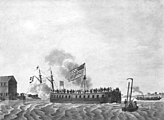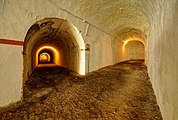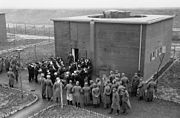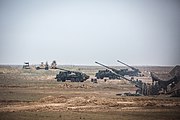Battery (military)
A battery (short Bt or Bttr ) refers to positions and military units of the artillery with guns , howitzers , rocket launchers , mortars or anti-aircraft cannons .
Origin and history
In the historical naval forces , a battery initially referred to any covered space with more than three guns, later the totality of the guns on one side of a warship . Ironclad ships were known as floating batteries . One example is the USS Fulton .
Since the rate of fire and the hit accuracy of the artillery were very limited in the early days , the guns were grouped together. These groups were called batteries, meaning: “What is necessary to strike” (from Latin : battuere , French : battre = to strike; bataille = battle, from this battalion ).
A field battery was the name given to a battery used in the field artillery used in the past . In the army of the German Empire in the 19th and the beginning of the 20th century, a distinction was made between
- driving battery in which the gunners during the march on the gun and the Protze sat;
- mounted battery in which the gunners rode next to the gun during the march. Due to the lighter gun, marching speed and mobility were increased.
- Foot artillery , with the gunners marching next to the gun.
Flak battery Tabar (1939)
today
Today, a battery corresponds to the company's artillery as a general term for the size of a military unit.
Germany
In the artillery of the Bundeswehr, the battery is normally divided into two firing platoons of four guns or launchers each. In addition, there is a battery command team and an additional survey team. During operations, the battery is assigned support forces for supplies and a medical team. See also missile artillery battalion .
In the Luftwaffe , a MIM-23 HAWK anti-aircraft battery consisted of two “fire sections” with three rocket launchers each.
In the army air defense of the Bundeswehr, a battery consisted of the leadership team and various other groups and troops either of three platoons with five weapon carriers each Wiesel 2 Ozelot or two platoons each with three anti-aircraft cannon tanks Gepard .
Austria
In the armed forces the (self-propelled howitzer) battery essentially consists of:
- Gun squadron (GsSta) with two gun platoons (GsZg) each with 4 howitzers under the command of the 1st officer (1.O)
- Command group with command group (KdoTrp) and fire control team (FLTrp) under the command of the battery commander (BtKdt) or fire control officer (FLO)
- Observation group (BGrp) with three observation teams (BTrp)
- Munitions group (MunGrp)
- Exploration and Surveying Group (EVGrp)
- Supply group (VersGrp) with medical team (SanTrp), maintenance team (WTrp), u. a.
- Computing team (ReTrp)
- Weather troop
During the fire fight, in addition to the GsSta, ReTrp, SanTrp and WTrp as well as at times MunGrp and EVGrp are located in the so-called firing room (FStR) over which the 1st officer has command.
Around 1983 there was an anti-tank anti-aircraft battery with aging tanks in the Hörsching barracks .
Switzerland
There are four different artillery batteries in the Swiss Army .
- Flt Bttr (fire control battery)
- Type Bttr (gun battery)
- Log Bttr (logistics battery)
- FFZ Bttr (Battery Fire Control Center)
The type of battery consists of:
- the shooting platoon, the gun platoon (Gesch Z) with 6 guns (of the type M109 KAWEST self-propelled howitzer),
- the supply train (Ns Z) and
- the command platoon (Kdo Z).
The supply train is responsible for the ammunition of the guns. This is carried out at so-called ammunition points, whereby the choice of location of these points is of decisive importance for the course of the battle and the standby time. The ammunition is either distributed with trucks (mostly at department level), in so-called "racks" (combination drawer made of projectiles, fuses and charges) or in the field with the unarmored M548 crawler vehicles .
The command platoon includes the commander (captain) and his team, the reconnaissance team, the command group, the fire control group and the rear service.
All platoons are led by lieutenants and first lieutenants .
For historical reasons, the anti-aircraft companies of the Swiss Air Force are also called batteries, which are grouped into departments .
literature
- H.Dv. 200/4 Training Regulations for Artillery - Book 4 Training of the Drawn Battery - From January 25, 1934, ISBN 978-3-7448-0927-6
See also
- Battery deck on ships
- Artillery troops (Wehrmacht)
- Artillery Troops (German Empire)
- Marine anti-aircraft gun




